Description
Chapter One — Overview
1.1 General part
This project intends to build a hazardous waste incineration device of 80t/d wastewater, 6.0t/d waste liquid, 11000Nm3/h waste gas and 500kg/d solid waste of Hubei Shengling Technology Co., Ltd., which is used to incinerate and treat hazardous waste generated by the plant.
The technical solution includes the procurement, installation and commissioning of a complete set of hazardous waste incineration devices, and the project site is in Laohekou City, Hubei Province. The project is equipped with a waste incinerator and its supporting waste feeding facilities, flue gas treatment system, ash removal system, automatic control system, interlocking alarm system, waste heat recovery system, emergency discharge, tail gas treatment, online monitoring system, etc.
1.1.1 Main systems and equipment components
|
No.
|
Equipment name
|
Unit
|
Remark
|
|
1
|
Feeding system
|
1 set
|
|
|
2
|
Combustion chamber
|
1 set
|
¢4200×16000mm
|
|
3
|
SNCR denitrification system
|
1 set
|
Equipped
|
|
4
|
Waste heat boiler
|
1 set
|
Rated evaporation capacity 10.0T/h
|
|
5
|
Economizer
|
1 set
|
Equipped
|
|
6
|
Bag filter dust removal system
|
1 set
|
Reserve space
|
|
7
|
Induced draft smoke exhaust system
|
1 set
|
90KW
|
|
8
|
Wet deacidification
|
1 set
|
Reserve space
|
|
9
|
Auxiliary air system
|
1 set
|
30KW
|
|
10
|
Auxiliary combustion system
|
1 set
|
2.5 million kcal*2
|
|
11
|
Compressed air supply system
|
1 set
|
Equipped
|
|
12
|
Electrical instrument automatic control system
|
1 set
|
PLC control
|
Note: This incinerator cannot be used to incinerate wastes containing flame retardant substances, high halides, and high salt content.
1.1.2 Flue gas emission standards
Table 1 "Hazardous Waste Incineration Pollution Control Standard" GB18484-2020
|
No.
|
Pollutant item
|
Limit
|
Value time
|
|
1
|
Particulate matter (mg/Nm3)
|
30
|
1-hour mean
|
|
20
|
24-hour mean or daily mean
|
|
2
|
Carbon monoxide (mg/Nm3)
|
100
|
1-hour mean
|
|
80
|
24-hour mean or daily mean
|
|
3
|
Nitrogen oxides (in NO2, mg/Nm3)
|
300
|
1-hour mean
|
|
250
|
24-hour mean or daily mean
|
|
4
|
Sulfur dioxide (mg/Nm3)
|
100
|
1-hour mean
|
|
80
|
24-hour mean or daily mean
|
|
5
|
Hydrogen fluoride (mg/Nm3)
|
4.0
|
1-hour mean
|
|
2.0
|
24-hour mean or daily mean
|
|
6
|
Hydrogen chloride (mg/Nm3)
|
60
|
1-hour mean
|
|
50
|
24-hour mean or daily mean
|
|
7
|
Mercury and its compounds (in Hg, mg/Nm3)
|
0.05
|
Measured mean
|
|
8
|
Thallium, cadmium and their compounds (in Tl+Cd, mg/Nm3)
|
0.05
|
Measured mean
|
|
9
|
Lead and its compounds (in Pb, mg/Nm3)
|
0.5
|
Measured mean
|
|
10
|
Arsenic and its compounds (in As, mg/Nm3)
|
0.5
|
Measured mean
|
|
11
|
Chromium and its compounds (in Cr, mg/Nm3)
|
0.5
|
Measured mean
|
|
12
|
Tin, antimony, copper, manganese, nickel and their compounds (in Sn+Sb+Cu+Mn+Ni, mg/Nm3)
|
2.0
|
Measured mean
|
|
13
|
Dioxins (ngTEQ/Nm3)
|
0.5
|
Measured mean
|
1.2 Main design principle
The general incineration device is the harmful waste gas, waste liquid, solid waste through incineration into harmless substances, discharged into the atmosphere, so that the discharge of three wastes to meet the national environmental standards, no secondary pollution, and as far as possible the heat generated in the incineration process recovery.
The design of the device and process is reasonable and reliable to prevent harmful substances from hurting people. The process equipment of the device should be strictly implemented in the design and manufacture of the relevant national standards and specifications, and the design and manufacture quality should reach the domestic advanced level.
The system must be reliable, cannot leak, must have the reliable protection measure in the accident state. At the same time, consider the economy and rationality of its operation. The overall design of the installation should basically realize the "five" principles of integration, open-air, light, socialization and localization.
1.2.1 Main design basis
Relevant regulations, norms and technical standards issued by the state.
1.2.2 Design scope
Design, supply, installation and corresponding services of a complete set of waste incineration system with a treatment capacity of 80t/d wastewater, 6.0t/d waste liquid, 11000Nm3/h waste gas and 500kg/d solid waste.
1.2.3 Main design parameters
Incineration capacity:
|
Item
|
Hourly processing capacity of a single furnace
|
Daily processing capacity of a single furnace
|
|
Waste water
|
3333kg/h
|
80 t
|
|
Waste liquid
|
250kg
|
6.0 t
|
|
Waste gas
|
11000m3/h
|
264000m³
|
|
Solid
|
21kg
|
500kg
|
Overload capacity: 10%
Flue gas emission index:
Flue gas emission index implements the "Hazardous Waste Incineration Pollution Control Standard" GB18484-2020.
Note: The flue gas emission limit requirement is based on 11% O2 (dry gas). If the standard approved by the environmental impact assessment is stricter than the above emission standards, the environmental impact assessment approval shall prevail.
Noise emission standard requirements:
Noise emission standards comply with Class III standards in GB12348-2008 "Environmental noise emission standards for industrial enterprises", ≤65 decibels during the day and ≤55 decibels at night.
Residue and fly ash emission requirements:
According to hazardous waste (inorganic matter)
1.2.4 Safety and environmental protection requirements
The feeding port of the equipment is closed with negative pressure, and no harmful gas leaks
Low-noise equipment is selected to meet noise control specifications.
The device is designed with a safety platform and ladder to facilitate the operation and maintenance of spare parts.
Design interlocking and emergency discharge protection functions such as safety shutdown, over-temperature, and over-limit.
Chapter Two — Process Part
2.1 Overview
Incineration method is a kind of high temperature pyrolysis processing technology, namely with a certain amount of excess air and be processed in organic waste incinerator combustion reaction, waste of harmful toxic substances in the 800℃-1200℃ high temperature oxidation, pyrolysis, which is a kind of waste harmless, reduction and recycling treatment technology. The purpose of incineration is to incinerate waste as far as possible, so that the incinerated substances become harmless and minimize capacity, and reduce the generation of new pollutants to avoid secondary pollution. For the waste incineration, it can simultaneously achieve the reduction of waste, complete incineration of toxic substances in waste, and recycling of waste heat generated by incineration.
Incineration is a thermal technique for disposing of waste by burning. Combustion is a violent oxidation reaction, often accompanied by light and heat phenomenon, that is, radiant heat, often accompanied by flame phenomenon, will lead to an increase in ambient temperature. There are three main components in a combustion system: fuel or combustible matter, oxide and inert matter. Fuels are organic materials containing high energy chemical bonds such as carbon, hydrocarbon and hydrogen. These chemical bonds give off heat energy after oxidizing; Oxide is an indispensable substance in combustion reaction. The most common oxide is air containing 21% oxygen. The amount of air and the degree of mixing with fuel directly affect the efficiency of combustion. Inert materials are not directly involved in the combustion process. The combustion process of combustible materials is more complex. It usually consists of thermal decomposition, melting, evaporation, chemical reaction and other heat and mass transfer processes.
2.2 The main process flow chart is as follows
Automatic loading system – Automatic feeding system – Vertical furnace – SNCR – Waste heat boiler – Economizer – Bag filter (reserved) – Spray scrubber (reserved) – induced draft fan – Chimney – Emission
2.3 Brief description of the main process
1) First, turn on the air blower to purge the residual gas and other flammable and explosive gases in the furnace to prevent explosion after ignition.
2) Before igniting the ignition burner, turn on the induced draft fan and purge the furnace for five minutes. The auxiliary fuel, natural gas or waste methanol, is transported through pipelines and ignited by the ignition burner. The burner releases heat, causing the temperature in the combustion chamber to slowly rise.
3) The waste liquid and waste water enter the combustion chamber through the atomizing spray gun, and the glutaraldehyde exhaust gas enters the combustion chamber through the oxygen supply fan. The solids are in the form of fine particles and are blown to the combustion chamber by the fan of the acrolein exhaust gas, and are quantitatively fed through the star unloader.
4) The temperature of the flue gas generated by the incineration increases to 960°C under the full disturbance of the oxygen supply wind, making the incineration more complete and achieving the effect of smokeless, odorless and no secondary pollution. The residence time of the flue gas in the combustion chamber is ≥4.0 Seconds, the trace organic matter and dioxins in the flue gas can be fully decomposed, and the decomposition efficiency exceeds 99.99%, ensuring that the undecomposed organic components and carbon particles in the flue gas are completely decomposed at a temperature of about 960°C. Multi-stage combustion is used in the combustion chamber, which effectively suppresses the generation of nitrogen oxides.
5) The flue gas from the combustion chamber enters the waste heat steam boiler and economizer. A 10% urea solution is sprayed into the front flue of the boiler for SNCR reduction and denitrification to remove NOx in the flue gas. Then the high-temperature flue gas is exchanged with the boiler evaporation tube bundle. Heat, 1.0MpaG saturated steam is produced and enters the factory pipe network. The outlet temperature of the economizer is about 200°C.
6) Reserve a bag dust collector and a spray scrubber, and the flue gas that reaches the standard will be discharged into high altitude through the chimney.

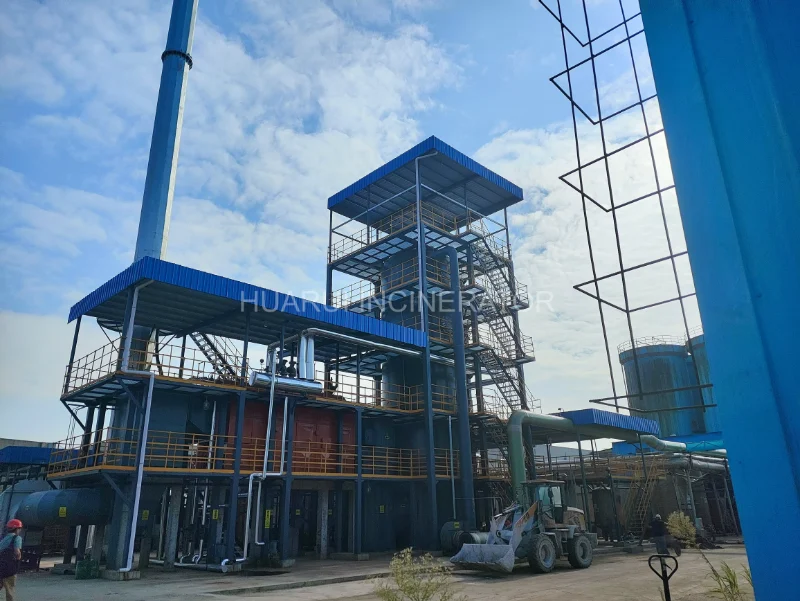
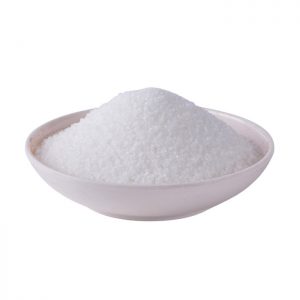
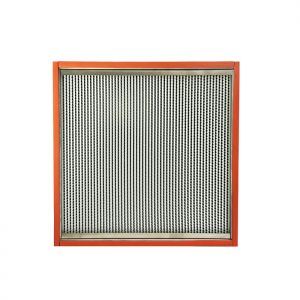
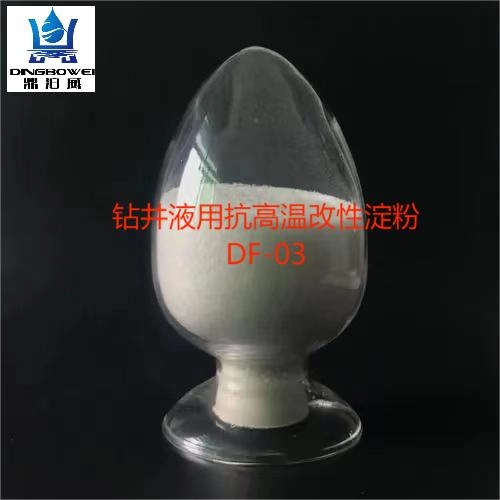
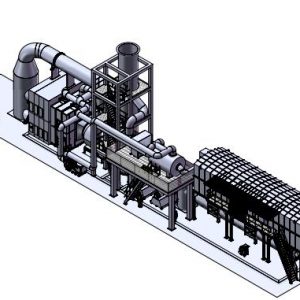
Reviews
There are no reviews yet.